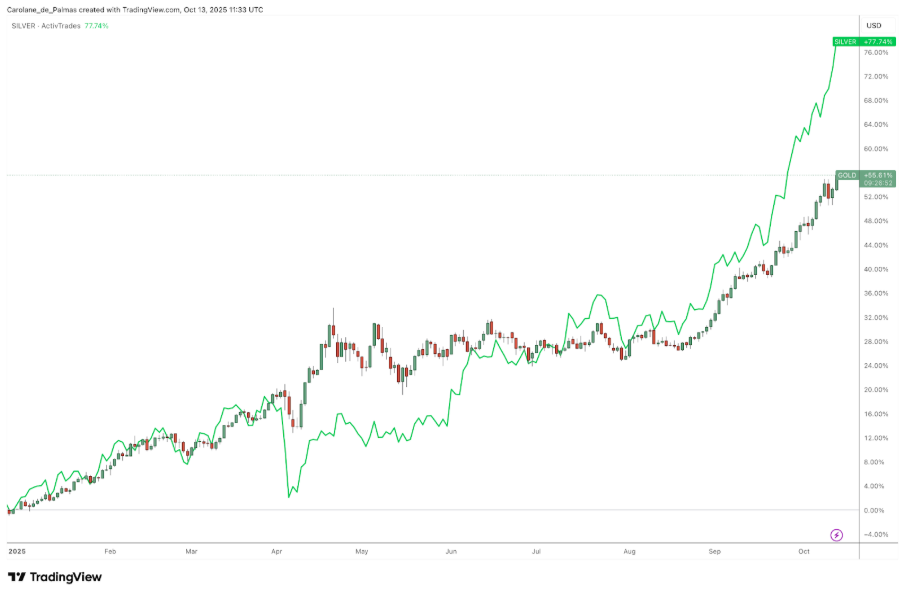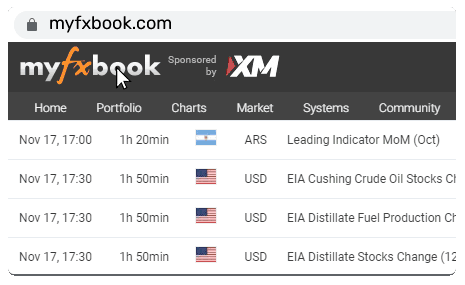Gold and Silver at Record Highs: Rally or Reversal Ahead?

Gold and Silver have surged to new record highs, with prices climbing above $4,079 per ounce and $51 per ounce respectively, as investors seek refuge from a growing list of global uncertainties. While headlines remain dominated by the U.S. government shutdown and renewed trade tensions between Washington and Beijing, a deeper set of forces is driving the rally.
Concerns over central bank independence, expectations of further Federal Reserve rate cuts, and record inflows into Gold-backed ETFs have all strengthened the case for precious metals. At the same time, central bank purchases and Silver’s dual role as both an industrial and safe-haven asset are reinforcing the upward momentum.
Political risks—from France’s domestic instability to uncertainty over Japan’s next government—are adding another layer of caution for global investors. With confidence in traditional assets being tested and inflation expectations still elevated, Gold and Silver are reasserting themselves as key hedges in a volatile macroeconomic environment.
But the key question now is whether this momentum can last. Are these record highs the beginning of a longer bull market—or a temporary spike driven by fear and speculation? Analysts remain divided as they assess how sustainable this rally really is.
 Gold and Silver Chart - Source: TradingView with ActivTrades’ Data
Gold and Silver Chart - Source: TradingView with ActivTrades’ Data
U.S.–China Tensions Return to the Spotlight
Rising friction between Washington and Beijing has reignited fears of a renewed trade war, adding fuel to safe-haven demand for Gold and Silver.
Last Friday, U.S. President Donald Trump announced a sweeping new round of tariffs on Chinese imports, effectively ending the fragile trade truce between the world’s two largest economies. The plan includes a 100% levy on U.S.-bound Chinese goods and new export controls on critical software, set to take effect by November 1 — just days before existing tariff relief expires.
The move is likely coming in response to China’s decision to expand export restrictions on rare earth elements, a group of minerals essential for the production of high-tech and defense equipment. Beijing’s latest controls — adding five new elements to the list, including holmium, erbium, thulium, europium, and ytterbium — will take effect on November 8. These materials are vital for industries ranging from electric vehicles to military radars, and China currently produces over 90% of the world’s processed rare earths.
The export rules now also cover foreign companies using Chinese-made materials or equipment, even if no Chinese firms are directly involved in the transaction. This broadens the impact significantly, potentially disrupting global supply chains for advanced manufacturing and defense industries.
The escalation follows several smaller flashpoints in recent days, such as U.S. proposals to ban Chinese airlines from flying over Russia on U.S. routes, and the removal of Chinese electronics from major American online retailers by the Federal Communications Commission.
While Trump later struck a more conciliatory tone on social media — saying that “everything will be fine” and the U.S. does not want to “hurt China” — Beijing has already warned it will retaliate if Washington goes ahead with the 100% tariffs.
The renewed uncertainty surrounding U.S.–China relations has pushed investors toward safe-haven assets, driving demand for both Gold and Silver as hedges against geopolitical and economic instability.
Growing Expectations of U.S. Rate Cuts
Beyond geopolitics, expectations for lower U.S. interest rates are providing additional support to precious metals. Gold and Silver, which do not yield interest, tend to benefit when borrowing costs fall and the U.S. dollar weakens.
Traders are now pricing in two additional Federal Reserve rate cuts before the end of the year — a 25-basis-point reduction in both October and December — with probabilities of 95% and nearly 80%, respectively. The Fed’s next key event will be Chair Jerome Powell’s address at the National Association for Business Economics (NABE) annual meeting on Tuesday, where investors hope for more guidance on the central bank’s policy path.
Several other Fed officials are also scheduled to speak this week, but the ongoing U.S. government shutdown is complicating the outlook by delaying critical economic data releases, including the Consumer Price Index (CPI) and Personal Consumption Expenditures (PCE) inflation reports.
Although the Fed’s October 28–29 meeting will proceed as planned — since the institution is independently funded — policymakers may have to rely more heavily on private-sector data in the absence of official statistics. The uncertainty surrounding the economic picture increases the likelihood that the Fed will err on the side of caution and proceed with additional rate cuts.
With geopolitical risks rising and monetary policy expected to loosen, investors are increasingly turning to Gold and Silver as dual hedges — against both economic slowdown and financial market volatility.
What Other Factors Are Supporting Gold and Silver Prices?
Beyond geopolitical tensions and expectations of lower U.S. interest rates, several other forces are contributing to the record highs in Gold and Silver prices, each with its own dynamics.
One of the most important factors is growing concern over the independence of the U.S. Federal Reserve. Last month, Goldman Sachs warned that if political pressure undermines the Fed’s autonomy, the result could be higher inflation, weaker stock and bond markets, and a sharp rise in Gold prices as investors seek protection. The bank even suggested that in an extreme scenario, Gold could climb as high as 5,000 dollars per ounce. ING shares a similarly bullish outlook, forecasting an average of 4,000 dollars per ounce in the fourth quarter of this year and 4,150 dollars per ounce in 2026.
Another powerful tailwind comes from the investment side, particularly through Gold-backed exchange-traded funds (ETFs). According to the World Gold Council, global Gold ETFs saw record inflows in September, reaching 17 billion dollars for the month and 26 billion dollars for the quarter—the strongest on record. This surge shows how institutional and retail investors are positioning for further price appreciation. The trend is expected to continue in October as markets remain uncertain and investors diversify away from traditional assets.
Central banks are also playing a major role in supporting Gold prices. Data from the IMF and national central banks show that official institutions added a net 19 tonnes to their Gold reserves in August. This marks the fourth consecutive year of sustained buying by central banks across Asia and the Middle East. Their motivation goes beyond profit: many are gradually reducing their reliance on the U.S. dollar, which has become more politically and fiscally uncertain. This long-term shift toward Gold as a reserve asset reinforces global demand and provides a stable source of support for prices.
Silver, meanwhile, is benefiting from both its role as a safe-haven asset and its strong industrial demand. Often viewed as a more affordable alternative to Gold, Silver tends to attract investors when Gold prices rise sharply. But unlike Gold, Silver also has deep ties to manufacturing sectors such as solar energy, data centers, and electronics. The rapid expansion of these industries has created persistent demand pressures at a time when mining output has stagnated. The result is a structural supply deficit that has lasted five years, pushing prices higher.
Goldman Sachs analysts note that Silver should continue to rise in the medium term for the same reasons driving Gold—lower interest rates and increased investment flows. However, they also warn that Silver’s smaller and less liquid market makes it more volatile. One sign of this tightness is the spike in Silver lease rates, which rose more than 35% as investors pay record premiums to secure immediate access to the metal. Scarcity of available bars in London vaults, the main hub for physical Silver trading, has amplified the rally. Some inventories were moved to the U.S. earlier this year as traders prepared for potential tariff disruptions, further reducing supply in London.
At the same time, the rapid growth of Silver-backed ETFs has absorbed even more physical Silver, deepening the market imbalance. Analysts expect this situation to ease gradually as higher London prices encourage metal to flow back from the U.S. and other regions. Still, without the stabilizing presence of central bank buying—unlike Gold—Silver prices could remain more exposed to short-term corrections if investor flows slow down.
Sources: Reuters, Wall Street Journal, Investopedia, Euronews, ING Think, World Gold Council, CNBC
The information provided does not constitute investment research. The material has not been prepared in accordance with the legal requirements designed to promote the independence of investment research and as such is to be considered to be a marketing communication.
All information has been prepared by ActivTrades (“AT”). The information does not contain a record of AT’s prices, or an offer of or solicitation for a transaction in any financial instrument. No representation or warranty is given as to the accuracy or completeness of this information.
Any material provided does not have regard to the specific investment objective and financial situation of any person who may receive it. Past performance is not a reliable indicator of future performance. AT provides an execution-only service. Consequently, any person acting on the information provided does so at their own risk. Forecasts are not guarantees. Rates may change. Political risk is unpredictable. Central bank actions may vary. Platforms’ tools do not guarantee success.
-362025100.png)
-362025100.png)



















